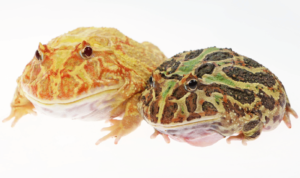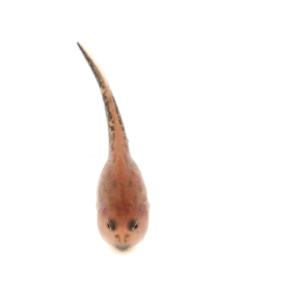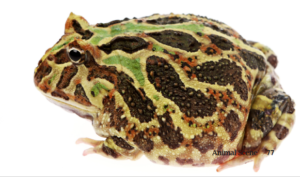Q: The Pacman frog is an unusual yet cute creature. Can you give us a basic introduction to it and how it came to be in the Philippines? How big can you expect it to grow, how long is its lifespan, and what other basics should those interested in it know? Is it known by other names?
The Pacman Frog is a terrestrial frog endemic to the dry Gran Chaco region of Argentina, Bolivia, Paraguay, and Brazil. Adults can grow 8–13 centimeters or cm long (3–5 inches or in) and can weigh up to half a kilogram (about one pound). Their lifespan is about 5 years in the wild, and if kept right with good husbandry techniques, they can live up to 10 – 15 years in captivity.

Q: What for you are the defining characteristics of the Pacman frog, the thing or things that make them special and/or distinguishes them from other, similar creatures?
Its round, broad body that makes it look similar to the main character Pacman in the game that was popular back in the 80s. Aside from the cute physique, they come in a variety of colors, depending on morphs and species.
Q: Was it difficult for you to raise a Pacman frog? What are the best things you’ve learned about keeping it, in your experience? What challenges did you face in its care, and how did you overcome these?
It is a beginner’s pet, so it requires minimal maintainance. Just be sure to give it a 10 gallon tank and coco peat substrate. Never stress them out, as they will not eat when stressed. Proper husbandry is the key to success in keeping these frogs. You need the right kind of habitat/enclosure; you should maintain the right humidity levels, and offer them a good variety in their staple diet.

Q: Do their care requirements vary from other, similar creatures? Do they need a lot of attention? Do they need a special diet? What do they eat? What kind of exercise do they require? Will they need a special habitat?
Always wash your hands before handling them. Their skin is very sensitive to oil and other skin lotions or chemical remnants. They are solitary and cannot be housed with others of the same kind as they are cannibalistic. They eat almost anything that moves, from mice, worms, crickets, fish, small birds, lizards, and snakes. That’s another reason why they’re called Pacman frogs: they eat anything and everything in their way!
Caution: they don’t tolerate being handled; they tend to get stressed out if they are handled. They do not require any exercise, unlike mammals. They conserve their energy for hunting and digesting their prey.
Q: What are the characteristics of a healthy Pacman frog?
Conversely, what signs should keepers look out for that indicate when it is sick? What are its common health problems that keepers should watch out for?Healthy Pacman frogs have clear eyes; they should not limp not have lame legs. Their snouts should be perfectly round, and there should be no signs that they are bloated.If they are ill, watch out for cloudy eyes, bloatedness, imperfect belly lumps, lethargy, weakness, and refusal to eat. Red dots are a sign of a fungi-infested red leg.

Q: Are there misconceptions about Pacman frogs that you would like to correct among those who have heard of it but who do not know it well?
They are not an invasive species. They are not aquatic types of frogs. They love to burrow to set up an ambush as they wait for prey. They can go without food for as long as 2 weeks. In the winter, they can estavate (a form of hibernation in which the creature sleeps though the summer instead of the winter) for as long as two months.
Q: For someone who is interested in keeping a Pacman frog for a pet, can you give them things to consider before taking the plunge? Who would they make ideal pets for? Or are they better suited to aficionados who want to study them?
It’s best if the potential keeper is aged 15 and up. Pacman frogs have been in the exotic pet trade for some time and are very popular. If you are buying one, be responsible and do your research before keeping one.
Q: How much of a commitment does it take to keep a Pacman frog, and what advice would you have for someone who is keeping them for the first time? Were there any mistakes that you made as a beginner that you feel other beginners should learn from?
You need to be fully committed, as you have to regularly clean their enclosure and feed them, once a week for adults and every other day for juveniles. It all depends on the dedication of the individual keeper.

Q: Are there any risks involved in keeping Pacman frogs? If so then what is your advice on how to best avoid or lessen these risks?
They pack a powerful bite that can inflict a painful injury. Never handle a Pacman frog by the mouth; never grab them, for they are always hungry.Always separate Pacman frogs in their enclosure as they tend to be cannibalistic.If threatened, they pump up air, making them appear bigger; this is their defense mechanism to ward off predators. It will also squeal to intimidate predators.
Q: What, in your experience, are the best tips for taking care of the Pacman frog?
Are there any unique situations you’ve encountered and solved?Never leave the frogs 24/7 in the water for it will cause water edema and toxic out syndrome. Always keep the enclosure clean. Change the water in their water dish regularly.
Q: How does the Pacman frog interact with humans? Can they show affection the way traditional pets do, or do they express themselves another way?
None! Nothing, they just sit there waiting to eat. They are amphibians and their brain function is to reproduce and survive, to adapt against all odds.

Q: What is the ideal age to breed Pacman frogs? What are the signs that they are ready for breeding? What are the main challenges encountered when breeding pacman frogs in the Philippines?
When they are adults; females are ready to breed when they are 2 years old. It’s really hard to tell or see the signs of when they are ready to breed; sometimes you have to rely on the weather. It’s really complicated.
Q: How do you care for Pacman frog tadpoles? How long does it take before they turn into froglets? What diet do they require?
Change their water change once or twice a day, especially if you see the water is cloudy. Whether you use stagnant or running water, they will be okay. Food must always be available or they will eat each other. Tadpoles don’t grow at the same rate so it takes anywhere from 28-35 days. You can give them mosquito larvae, fish fry, baby brine shrimp and other commercial fish fry food products available in pet stores. Note: they don’t eat fish pellets. They prefer live food.
This appeared in “Meet the Pacman Frog” in Animal Scene’s December 2015 issue.






